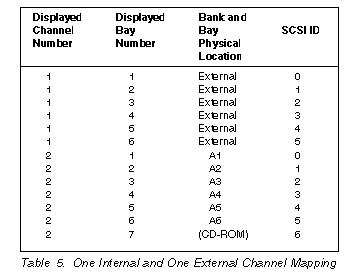

|
76.156 bytes |
Parts Information |
Document ID: DDSE-44RNVF |
Servers - External SCSI Devices
Applicable to: World-Wide
External SCSI Devices
You cannot use both internal connectors on the SCSI-2 adapter and also use the external connector. For disk-array models with the SCSI-2 Fast/Wide PCI-Bus Adapter, you cannot use the internal channel 1 connector and the external connector at the same time. If you intend to use the external connector, connect internal SCSI-2 devices to the internal channel 2 connector. See the following figure.

Termination Requirements
The requirements for terminating external SCSI devices are:
If you attach both internal and external SCSI devices, you must terminate the last internal device and the last external device. For non-disk-array models, you must also change the termination setting of the SCSI-2 adapter in the SCSISelect utility program, so that the SCSI-2 adapter is no longer terminated.
If you attach only external devices to the SCSI-2 adapter, you must terminate the last device on the cable. If you install only one external device, it must be terminated. Since the SCSI-2 adapter is already terminated, do not change the termination setting.
Cabling Requirements
Before you install external SCSI devices, you must have the correct external SCSI cables. See Table 1 for information on cable lengths. The cables must have the proper connector for the SCSI-2 adapter on one end, and the proper connector for the first external device on the other end.
The SCSI-2 Fast/Wide PCI-Bus adapter can support a total of 15 devices and the SCSI-2 PCI-Bus RAID adapter can support a total of 14 devices, provided that you do not exceed the maximum cable lengths listed in Table 4.
If you are using a SCSI data transfer rate greater than 5MB per second, the maximum length of the SCSI bus (cable) must not exceed 3 meters (9.8 feet). If you are using a SCSI data transfer rate of 5MB per second or slower, the maximum length of the SCSI bus cable must not exceed 6 meters (19.7 feet). These lengths apply to the combined lengths of the internal and external cables. Adhering to these standards ensures that the server operates properly.
The following table shows the maximum cable lengths for connecting SCSI devices, based on data-transmission rates.
Note
The maximum cable length for an external cable is determined by subtracting the length of the internal cable being used from the maximum length of SCSI cable that can be used based on the speed of the data transfer.

Setting SCSI IDs for External Devices
The internal channel connector (you can only use one of the two internal channel connectors) and the external channel connector on the SCSI-2 Fast/Wide PCI-Bus Adapter accept SCSI IDs from 0 through 7. Each device attached to the external channel connector must have a unique SCSI ID and each device attached to the internal channel connector must have a unique SCSI ID.
For example, you can have a SCSI ID of 0 on a device attached to the channel 1 connector and a SCSI ID of 0 on a device attached to the channel 2 connector of the same SCSI-2 Fast/Wide PCI-Bus Adapter. However, you cannot have a SCSI ID of 0 on two devices attached to the same channel connector.
Note
Read the README file on the SCSI-2 Fast/Wide PCI-Bus Adapter Configuration Option Diskette for updated information. Select Option Diskette from the first menu screen.
The following table shows an example of using one internal and one external channel on the RAID adapter. Channel 2 is connected to bank A and Channel 1 is attached to an external DASD storage enclosure. Refer to the documentation supplied with the storage enclosure for physical locations.

You must set a unique SCSI ID for each external SCSI device connected to the SCSI-2 Fast/Wide PCI Adapter. Therefore, do not set the SCSI IDs for external devices to the values that you use for internal devices. Refer to the instructions supplied with the SCSI devices for more information about setting a SCSI ID. The default ID for the SCSI-2 adapter is 7. The ID for the preinstalled CD-ROM drive is 3 on non-disk-array models, and 6 on disk-array models. If the disk-array server was supplied with a preinstalled hard disk drive in bay 1, the ID is 0.
Note
If you install a second SCSI-2 adapter, you can use the same SCSI IDs that you use for the preinstalled SCSI-2 adapter.
|
Search Keywords |
| |
|
Document Category |
CD-ROM Drives, Hard Drives, Optical Drives, SCSI, Tape Drives | |
|
Date Created |
03-02-99 | |
|
Last Updated |
03-02-99 | |
|
Revision Date |
03-02-2000 | |
|
Brand |
IBM PC Server | |
|
Product Family |
PC Server 300, PC Server 310, PC Server 320, PC Server 500, PC Server 520, PC Server 720, Rack/Storage Enclosures | |
|
Machine Type |
8640, 8639, 8641, 8642, 3517, 3518 | |
|
Model |
| |
|
TypeModel |
| |
|
Retain Tip (if applicable) |
| |
|
Reverse Doclinks |